Deqiang Jiang
VITA-VLA: Efficiently Teaching Vision-Language Models to Act via Action Expert Distillation
Oct 10, 2025Abstract:Vision-Language Action (VLA) models significantly advance robotic manipulation by leveraging the strong perception capabilities of pretrained vision-language models (VLMs). By integrating action modules into these pretrained models, VLA methods exhibit improved generalization. However, training them from scratch is costly. In this work, we propose a simple yet effective distillation-based framework that equips VLMs with action-execution capability by transferring knowledge from pretrained small action models. Our architecture retains the original VLM structure, adding only an action token and a state encoder to incorporate physical inputs. To distill action knowledge, we adopt a two-stage training strategy. First, we perform lightweight alignment by mapping VLM hidden states into the action space of the small action model, enabling effective reuse of its pretrained action decoder and avoiding expensive pretraining. Second, we selectively fine-tune the language model, state encoder, and action modules, enabling the system to integrate multimodal inputs with precise action generation. Specifically, the action token provides the VLM with a direct handle for predicting future actions, while the state encoder allows the model to incorporate robot dynamics not captured by vision alone. This design yields substantial efficiency gains over training large VLA models from scratch. Compared with previous state-of-the-art methods, our method achieves 97.3% average success rate on LIBERO (11.8% improvement) and 93.5% on LIBERO-LONG (24.5% improvement). In real-world experiments across five manipulation tasks, our method consistently outperforms the teacher model, achieving 82.0% success rate (17% improvement), which demonstrate that action distillation effectively enables VLMs to generate precise actions while substantially reducing training costs.
TACO: Think-Answer Consistency for Optimized Long-Chain Reasoning and Efficient Data Learning via Reinforcement Learning in LVLMs
May 27, 2025Abstract:DeepSeek R1 has significantly advanced complex reasoning for large language models (LLMs). While recent methods have attempted to replicate R1's reasoning capabilities in multimodal settings, they face limitations, including inconsistencies between reasoning and final answers, model instability and crashes during long-chain exploration, and low data learning efficiency. To address these challenges, we propose TACO, a novel reinforcement learning algorithm for visual reasoning. Building on Generalized Reinforcement Policy Optimization (GRPO), TACO introduces Think-Answer Consistency, which tightly couples reasoning with answer consistency to ensure answers are grounded in thoughtful reasoning. We also introduce the Rollback Resample Strategy, which adaptively removes problematic samples and reintroduces them to the sampler, enabling stable long-chain exploration and future learning opportunities. Additionally, TACO employs an adaptive learning schedule that focuses on moderate difficulty samples to optimize data efficiency. Furthermore, we propose the Test-Time-Resolution-Scaling scheme to address performance degradation due to varying resolutions during reasoning while balancing computational overhead. Extensive experiments on in-distribution and out-of-distribution benchmarks for REC and VQA tasks show that fine-tuning LVLMs leads to significant performance improvements.
Break the Visual Perception: Adversarial Attacks Targeting Encoded Visual Tokens of Large Vision-Language Models
Oct 09, 2024



Abstract:Large vision-language models (LVLMs) integrate visual information into large language models, showcasing remarkable multi-modal conversational capabilities. However, the visual modules introduces new challenges in terms of robustness for LVLMs, as attackers can craft adversarial images that are visually clean but may mislead the model to generate incorrect answers. In general, LVLMs rely on vision encoders to transform images into visual tokens, which are crucial for the language models to perceive image contents effectively. Therefore, we are curious about one question: Can LVLMs still generate correct responses when the encoded visual tokens are attacked and disrupting the visual information? To this end, we propose a non-targeted attack method referred to as VT-Attack (Visual Tokens Attack), which constructs adversarial examples from multiple perspectives, with the goal of comprehensively disrupting feature representations and inherent relationships as well as the semantic properties of visual tokens output by image encoders. Using only access to the image encoder in the proposed attack, the generated adversarial examples exhibit transferability across diverse LVLMs utilizing the same image encoder and generality across different tasks. Extensive experiments validate the superior attack performance of the VT-Attack over baseline methods, demonstrating its effectiveness in attacking LVLMs with image encoders, which in turn can provide guidance on the robustness of LVLMs, particularly in terms of the stability of the visual feature space.
Talk With Human-like Agents: Empathetic Dialogue Through Perceptible Acoustic Reception and Reaction
Jun 18, 2024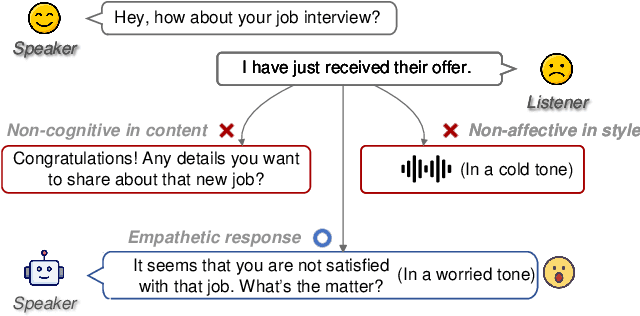
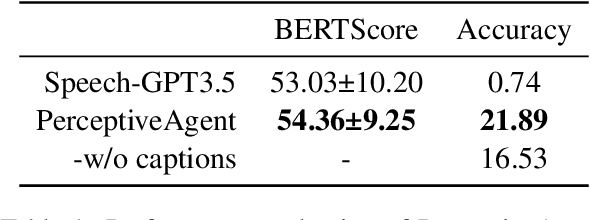
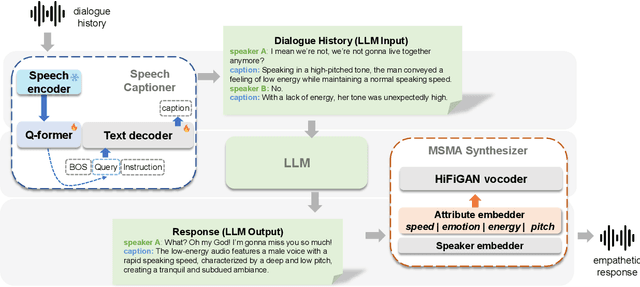

Abstract:Large Language Model (LLM)-enhanced agents become increasingly prevalent in Human-AI communication, offering vast potential from entertainment to professional domains. However, current multi-modal dialogue systems overlook the acoustic information present in speech, which is crucial for understanding human communication nuances. This oversight can lead to misinterpretations of speakers' intentions, resulting in inconsistent or even contradictory responses within dialogues. To bridge this gap, in this paper, we propose PerceptiveAgent, an empathetic multi-modal dialogue system designed to discern deeper or more subtle meanings beyond the literal interpretations of words through the integration of speech modality perception. Employing LLMs as a cognitive core, PerceptiveAgent perceives acoustic information from input speech and generates empathetic responses based on speaking styles described in natural language. Experimental results indicate that PerceptiveAgent excels in contextual understanding by accurately discerning the speakers' true intentions in scenarios where the linguistic meaning is either contrary to or inconsistent with the speaker's true feelings, producing more nuanced and expressive spoken dialogues. Code is publicly available at: \url{https://github.com/Haoqiu-Yan/PerceptiveAgent}.
HRVDA: High-Resolution Visual Document Assistant
Apr 10, 2024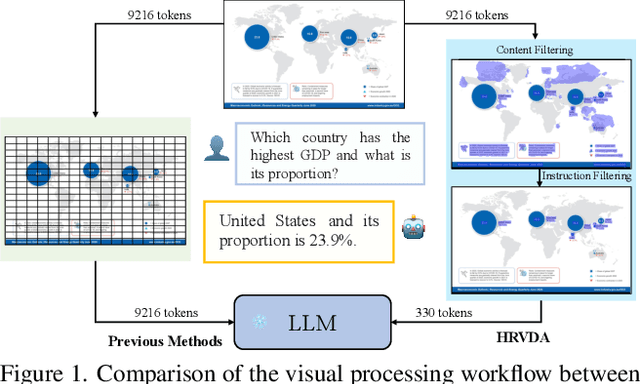
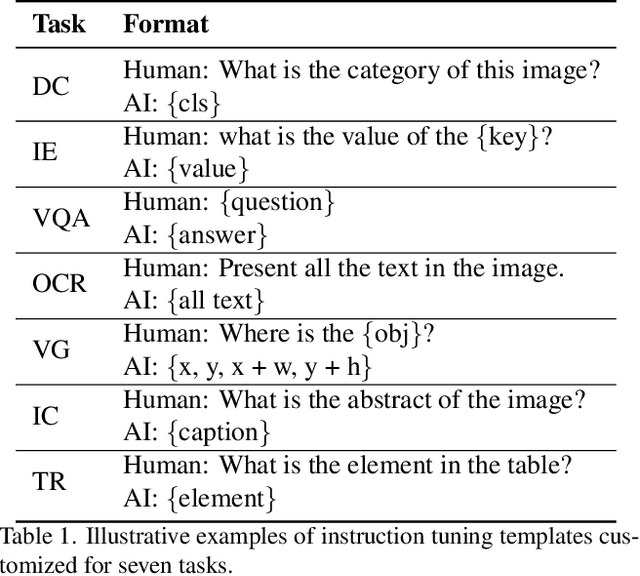
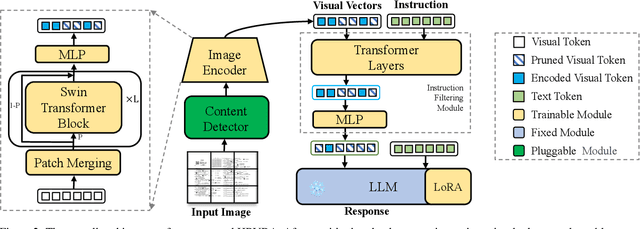

Abstract:Leveraging vast training data, multimodal large language models (MLLMs) have demonstrated formidable general visual comprehension capabilities and achieved remarkable performance across various tasks. However, their performance in visual document understanding still leaves much room for improvement. This discrepancy is primarily attributed to the fact that visual document understanding is a fine-grained prediction task. In natural scenes, MLLMs typically use low-resolution images, leading to a substantial loss of visual information. Furthermore, general-purpose MLLMs do not excel in handling document-oriented instructions. In this paper, we propose a High-Resolution Visual Document Assistant (HRVDA), which bridges the gap between MLLMs and visual document understanding. This model employs a content filtering mechanism and an instruction filtering module to separately filter out the content-agnostic visual tokens and instruction-agnostic visual tokens, thereby achieving efficient model training and inference for high-resolution images. In addition, we construct a document-oriented visual instruction tuning dataset and apply a multi-stage training strategy to enhance the model's document modeling capabilities. Extensive experiments demonstrate that our model achieves state-of-the-art performance across multiple document understanding datasets, while maintaining training efficiency and inference speed comparable to low-resolution models.
Enhancing Visual Document Understanding with Contrastive Learning in Large Visual-Language Models
Feb 29, 2024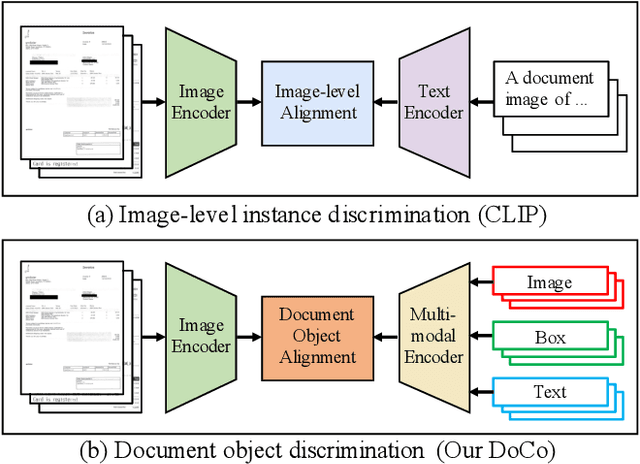
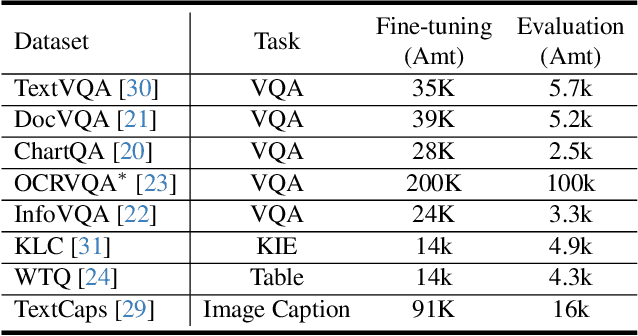
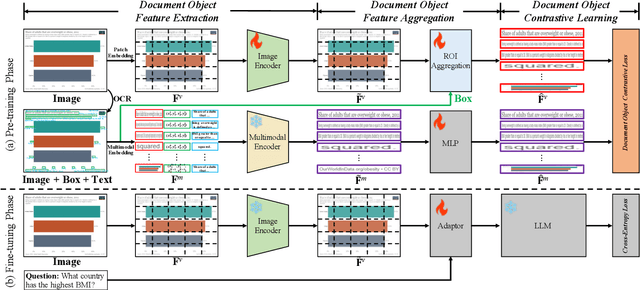

Abstract:Recently, the advent of Large Visual-Language Models (LVLMs) has received increasing attention across various domains, particularly in the field of visual document understanding (VDU). Different from conventional vision-language tasks, VDU is specifically concerned with text-rich scenarios containing abundant document elements. Nevertheless, the importance of fine-grained features remains largely unexplored within the community of LVLMs, leading to suboptimal performance in text-rich scenarios. In this paper, we abbreviate it as the fine-grained feature collapse issue. With the aim of filling this gap, we propose a contrastive learning framework, termed Document Object COntrastive learning (DoCo), specifically tailored for the downstream tasks of VDU. DoCo leverages an auxiliary multimodal encoder to obtain the features of document objects and align them to the visual features generated by the vision encoder of LVLM, which enhances visual representation in text-rich scenarios. It can represent that the contrastive learning between the visual holistic representations and the multimodal fine-grained features of document objects can assist the vision encoder in acquiring more effective visual cues, thereby enhancing the comprehension of text-rich documents in LVLMs. We also demonstrate that the proposed DoCo serves as a plug-and-play pre-training method, which can be employed in the pre-training of various LVLMs without inducing any increase in computational complexity during the inference process. Extensive experimental results on multiple benchmarks of VDU reveal that LVLMs equipped with our proposed DoCo can achieve superior performance and mitigate the gap between VDU and generic vision-language tasks.
A Challenger to GPT-4V? Early Explorations of Gemini in Visual Expertise
Dec 20, 2023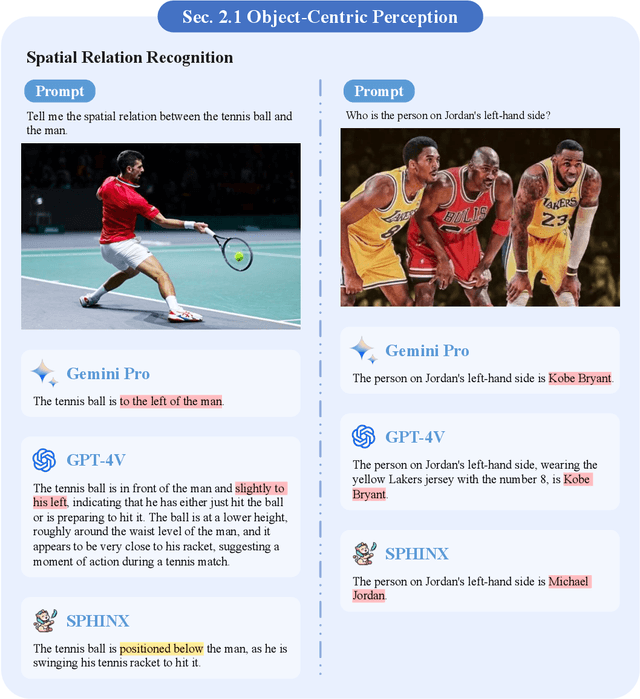

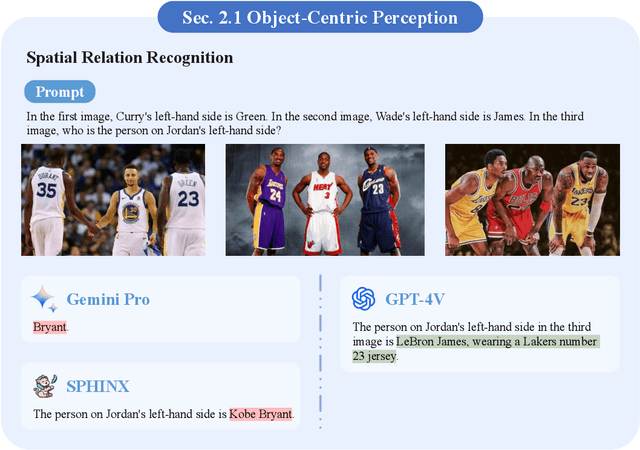
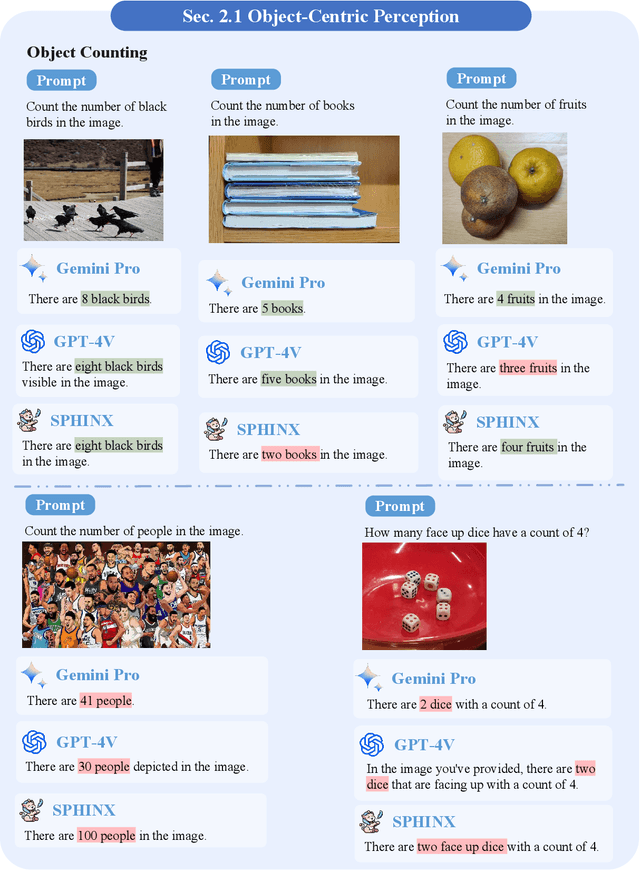
Abstract:The surge of interest towards Multi-modal Large Language Models (MLLMs), e.g., GPT-4V(ision) from OpenAI, has marked a significant trend in both academia and industry. They endow Large Language Models (LLMs) with powerful capabilities in visual understanding, enabling them to tackle diverse multi-modal tasks. Very recently, Google released Gemini, its newest and most capable MLLM built from the ground up for multi-modality. In light of the superior reasoning capabilities, can Gemini challenge GPT-4V's leading position in multi-modal learning? In this paper, we present a preliminary exploration of Gemini Pro's visual understanding proficiency, which comprehensively covers four domains: fundamental perception, advanced cognition, challenging vision tasks, and various expert capacities. We compare Gemini Pro with the state-of-the-art GPT-4V to evaluate its upper limits, along with the latest open-sourced MLLM, Sphinx, which reveals the gap between manual efforts and black-box systems. The qualitative samples indicate that, while GPT-4V and Gemini showcase different answering styles and preferences, they can exhibit comparable visual reasoning capabilities, and Sphinx still trails behind them concerning domain generalizability. Specifically, GPT-4V tends to elaborate detailed explanations and intermediate steps, and Gemini prefers to output a direct and concise answer. The quantitative evaluation on the popular MME benchmark also demonstrates the potential of Gemini to be a strong challenger to GPT-4V. Our early investigation of Gemini also observes some common issues of MLLMs, indicating that there still remains a considerable distance towards artificial general intelligence. Our project for tracking the progress of MLLM is released at https://github.com/BradyFU/Awesome-Multimodal-Large-Language-Models.
Attention Where It Matters: Rethinking Visual Document Understanding with Selective Region Concentration
Sep 03, 2023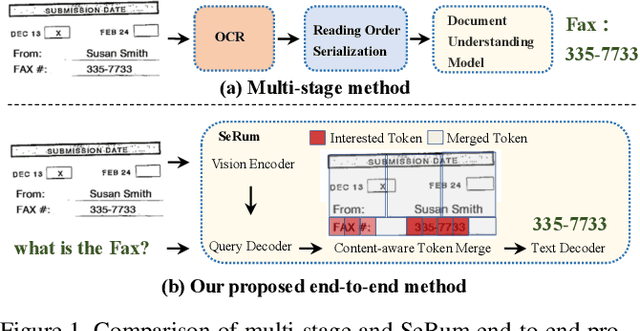


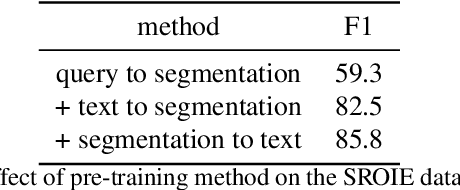
Abstract:We propose a novel end-to-end document understanding model called SeRum (SElective Region Understanding Model) for extracting meaningful information from document images, including document analysis, retrieval, and office automation. Unlike state-of-the-art approaches that rely on multi-stage technical schemes and are computationally expensive, SeRum converts document image understanding and recognition tasks into a local decoding process of the visual tokens of interest, using a content-aware token merge module. This mechanism enables the model to pay more attention to regions of interest generated by the query decoder, improving the model's effectiveness and speeding up the decoding speed of the generative scheme. We also designed several pre-training tasks to enhance the understanding and local awareness of the model. Experimental results demonstrate that SeRum achieves state-of-the-art performance on document understanding tasks and competitive results on text spotting tasks. SeRum represents a substantial advancement towards enabling efficient and effective end-to-end document understanding.
Looking and Listening: Audio Guided Text Recognition
Jun 06, 2023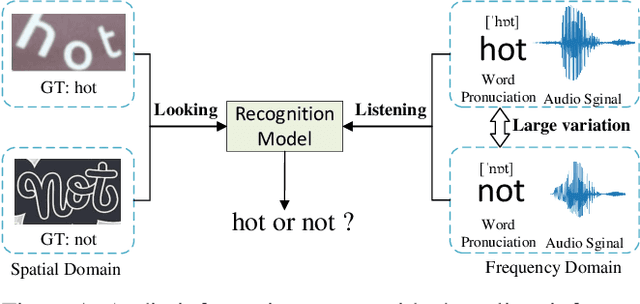
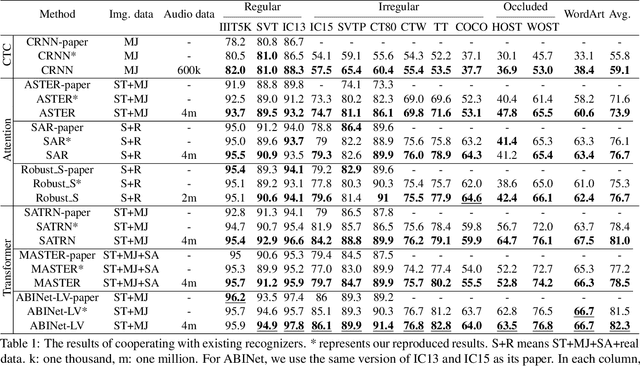
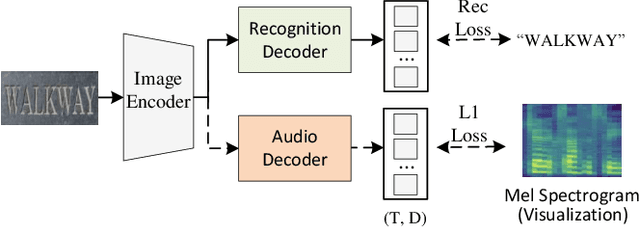
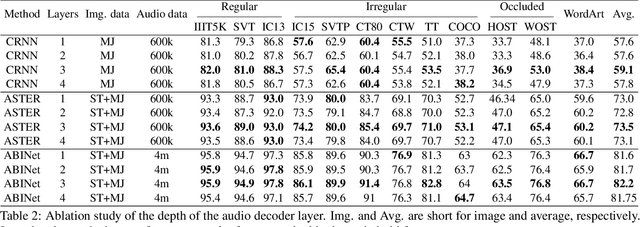
Abstract:Text recognition in the wild is a long-standing problem in computer vision. Driven by end-to-end deep learning, recent studies suggest vision and language processing are effective for scene text recognition. Yet, solving edit errors such as add, delete, or replace is still the main challenge for existing approaches. In fact, the content of the text and its audio are naturally corresponding to each other, i.e., a single character error may result in a clear different pronunciation. In this paper, we propose the AudioOCR, a simple yet effective probabilistic audio decoder for mel spectrogram sequence prediction to guide the scene text recognition, which only participates in the training phase and brings no extra cost during the inference stage. The underlying principle of AudioOCR can be easily applied to the existing approaches. Experiments using 7 previous scene text recognition methods on 12 existing regular, irregular, and occluded benchmarks demonstrate our proposed method can bring consistent improvement. More importantly, through our experimentation, we show that AudioOCR possesses a generalizability that extends to more challenging scenarios, including recognizing non-English text, out-of-vocabulary words, and text with various accents. Code will be available at https://github.com/wenwenyu/AudioOCR.
Visual Information Extraction in the Wild: Practical Dataset and End-to-end Solution
May 12, 2023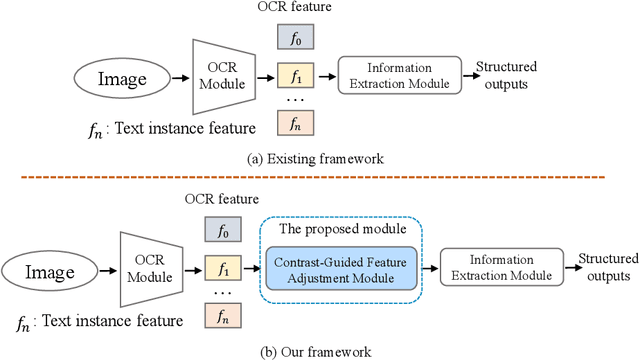

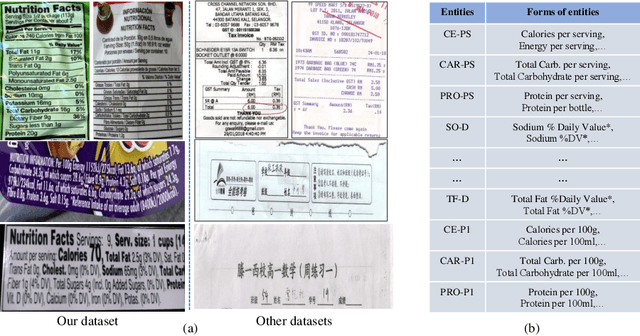

Abstract:Visual information extraction (VIE), which aims to simultaneously perform OCR and information extraction in a unified framework, has drawn increasing attention due to its essential role in various applications like understanding receipts, goods, and traffic signs. However, as existing benchmark datasets for VIE mainly consist of document images without the adequate diversity of layout structures, background disturbs, and entity categories, they cannot fully reveal the challenges of real-world applications. In this paper, we propose a large-scale dataset consisting of camera images for VIE, which contains not only the larger variance of layout, backgrounds, and fonts but also much more types of entities. Besides, we propose a novel framework for end-to-end VIE that combines the stages of OCR and information extraction in an end-to-end learning fashion. Different from the previous end-to-end approaches that directly adopt OCR features as the input of an information extraction module, we propose to use contrastive learning to narrow the semantic gap caused by the difference between the tasks of OCR and information extraction. We evaluate the existing end-to-end methods for VIE on the proposed dataset and observe that the performance of these methods has a distinguishable drop from SROIE (a widely used English dataset) to our proposed dataset due to the larger variance of layout and entities. These results demonstrate our dataset is more practical for promoting advanced VIE algorithms. In addition, experiments demonstrate that the proposed VIE method consistently achieves the obvious performance gains on the proposed and SROIE datasets.
 Add to Chrome
Add to Chrome Add to Firefox
Add to Firefox Add to Edge
Add to Edge